
The Toyota Supra Mk5 A90 has undeniably carved out a significant niche in the hearts of automotive enthusiasts globally. Since its reintroduction, this highly anticipated sports car has consistently impressed with its formidable power output, razor-sharp handling dynamics, and an overall performance envelope that places it firmly within the pantheon of sports car royalty. It represents a masterful blend of heritage and cutting-edge engineering, delivering an exhilarating driving experience straight from the factory floor.
However, for those who crave an even more visceral connection with their machine, or simply wish to push the boundaries of what the A90 Supra can achieve, the aftermarket world offers a tantalizing array of enhancements. While the stock form of this vehicle is already exceptional, a carefully curated selection of modifications can unlock levels of aesthetics, performance, and raw power that truly blow its original specifications out of the water. The journey to elevate this already remarkable platform is both exciting and deeply rewarding for any owner.
Our focus today is on navigating this exciting landscape of upgrades, highlighting some of the most popular and impactful modifications available for the Toyota Supra Mk5. These are not merely superficial tweaks but carefully engineered parts designed to integrate seamlessly with the A90’s sophisticated architecture, enhancing its inherent capabilities. Prepare to discover how you can transform your Mk5 Supra into an even more formidable road weapon, pushing its limits while retaining reliability and ensuring every drive is an unforgettable experience.
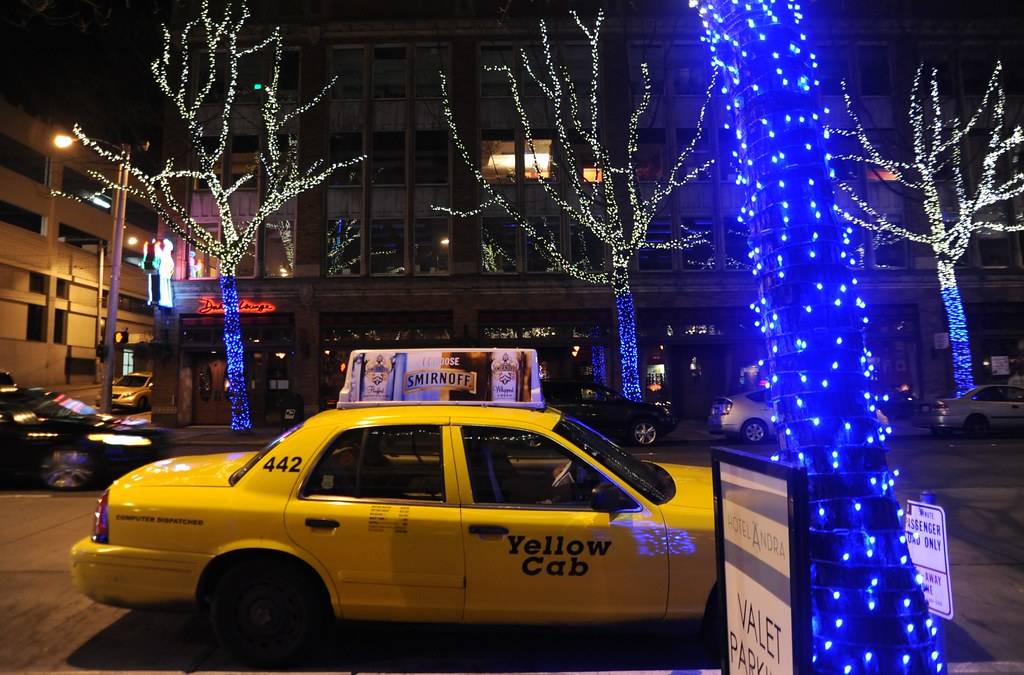
1. **GT Wing**One of the most visually striking and functionally effective modifications for the Toyota Supra Mk5, particularly for those who frequent high-speed circuits, is the addition of a GT wing. This isn’t merely an aesthetic statement; its primary purpose is to significantly enhance the car’s aerodynamics, ensuring the rear remains firmly planted, especially as velocities climb. For an already potent machine like the A90 Supra, optimizing downforce is crucial for stability and maximizing its performance potential on the track.
When considering a GT wing, brands like HKS stand out for their commitment to quality and engineering prowess. HKS is renowned for developing performance systems that are not only well-integrated and reliable but also environmentally conscious, reflecting a holistic approach to automotive enhancement. Their products are designed with the end-user in mind, making installation straightforward and user-friendly, allowing enthusiasts to upgrade their vehicle without unnecessary complications.
The specific design of a GT wing from HKS for the Supra Mk5 is meticulously crafted using Fiber Reinforced Plastics (FRP). This material choice ensures a robust yet relatively lightweight component, perfectly balancing durability with performance considerations. The kit typically includes the wing itself, along with the necessary stand, bracket, and a license plate cover, providing a comprehensive package for installation.
Crucially, the design process for such a wing involves rigorous testing on high-speed circuits. This scientific approach ensures that the product is optimized to generate optimal downforce precisely in the ultra-high-speed range, which is where it’s needed most to maintain vehicle control and stability. By improving the car’s aerodynamics, a GT wing allows the Supra to carve through corners with greater confidence and achieve higher speeds more securely, truly transforming its track performance.
Car Model Information: 2024 Toyota Supra 3.0 Premium
Name: Toyota Supra
Caption: Toyota GR Supra (J29/DB)
Manufacturer: Toyota
Aka: unbulleted list
Production: unbulleted list
Class: Sports car
BodyStyle: fastback,coupé
Layout: Front-engine, rear-wheel-drive layout
Predecessor: Toyota Celica (A20)
Categories: 1980s cars, 1990s cars, 2000s cars, 2010s cars, 2020s cars
Summary: The Toyota Supra (Japanese: トヨタ・スープラ, Hepburn: Toyota Sūpura) is a sports car and grand tourer manufactured and developed by the Toyota Motor Corporation beginning in 1978. The name “supra” is a definition from the Latin prefix, meaning “above”, “to surpass” or “go beyond”.
The initial four generations of the Supra were produced from 1978 to 2002. The fifth generation has been produced since March 2019 and later went on sale in May 2019. The styling of the original Supra was derived from the Toyota Celica, but it was longer. Starting in mid-1986, the A70 Supra became a separate model from the Celica. In turn, Toyota also stopped using the prefix Celica and named the car Supra. Owing to the similarity and past of the Celica’s name, it is frequently mistaken for the Supra, and vice versa. The first, second and third generations of the Supra were assembled at the Tahara plant in Tahara, Aichi, while the fourth generation was assembled at the Motomachi plant in Toyota City. The 5th generation of the Supra is assembled alongside the G29 BMW Z4 in Graz, Austria by Magna Steyr.
The Supra traces much of its roots back to the 2000GT owing to an inline-6 layout. The first three generations were offered with a direct descendant to the Crown’s and 2000GT’s M engine. Interior aspects were also similar, as was the chassis code “A”. Along with this name, Toyota also included its own logo for the Supra. It was derived from the original Celica logo, being blue instead of orange. This logo was used until January 1986, when the A70 Supra was introduced. The new logo was similar in size, with orange writing on a red background, but without the dragon design. That logo, in turn, was on Supras until 1991 when Toyota switched to its current oval company logo. The dragon logo was a Celica logo regardless of what colour it was. It appeared on the first two generations of the Supra because they were officially Toyota Celicas. The dragon logo was used for the Celica line until it was also discontinued.
In 1998, Toyota ceased sales of the fourth-generation Supra in the United States. Production of the fourth-generation Supra for worldwide markets ended in 2002. In January 2019, the fifth-generation Supra, which was co-developed with the G29 BMW Z4, was introduced.
Get more information about: Toyota Supra
Buying a high-performing used car >>>
Brand: Toyota Model: Supra
Price: $59,995 Mileage: 1,454 mi.
Read more about: Your Ultimate Guide to Savvy Negotiations: Simple Strategies for Securing the Best Price on a Rare Classic Car
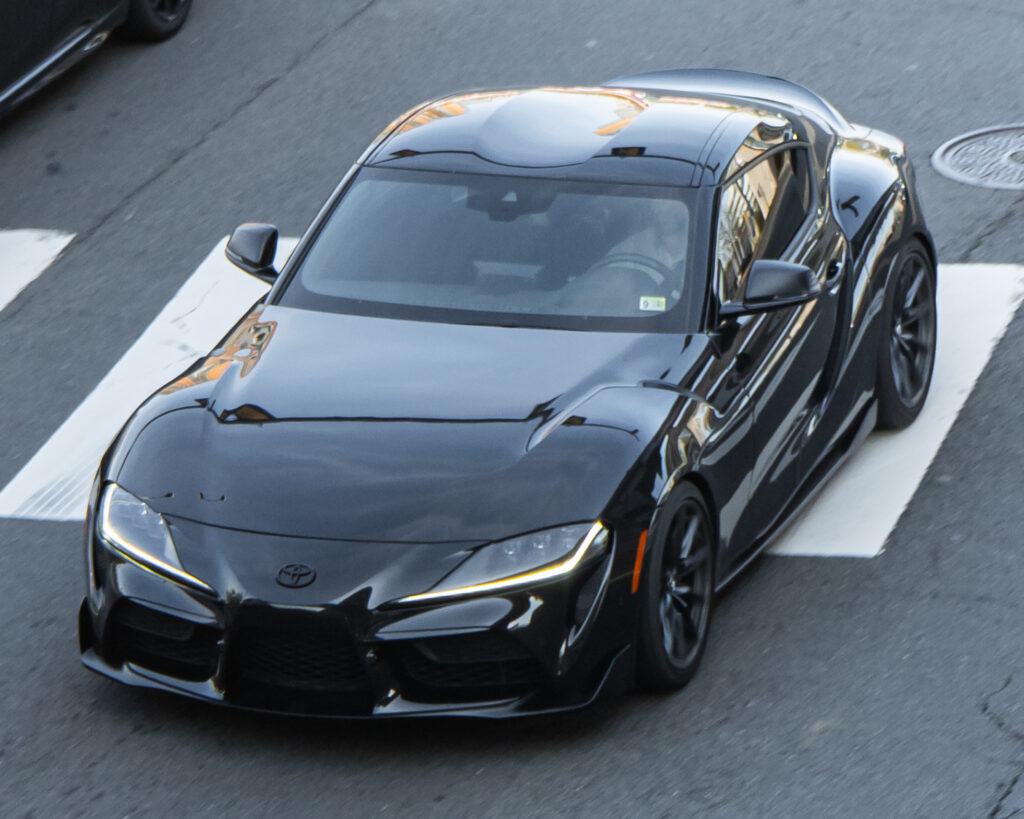
2. **Turbocharger**The Mk5 Supra, with its potent stock setup, is already an incredibly quick car, capable of rocketing from 0 to 60 mph in under 3.9 seconds. This rapid acceleration is impressive, yet for many performance enthusiasts, the pursuit of even greater power is an irresistible call. While the factory turbocharger is remarkably robust and has demonstrated its ability to reliably support substantial horsepower figures, a dedicated turbo upgrade can unleash an even more significant surge of power, pushing the A90’s capabilities to new extremes.
For those looking to elevate their Supra’s engine performance, Pure Turbos has established itself as an industry leader in high-performance turbochargers. Their reputation is built on delivering cutting-edge technology and uncompromising quality, making them a go-to brand for serious power upgrades. The Pure800 Turbo Upgrade for the Toyota Supra MK5 is a prime example of their engineering excellence, representing a high-quality kit guaranteed to boost both the efficiency and raw power of the engine.
The performance gains achieved with the Pure800 turbo are nothing short of phenomenal. When paired with pump gas and methanol injection, this upgrade can yield an impressive 630 wheel horsepower (whp). For those opting for race gas and methanol, the output climbs even higher to an astounding 672 whp. These figures indicate a dramatic increase over the stock power, translating into a vastly more aggressive and exhilarating driving experience both on the street and at the track.
Furthermore, the Pure800 turbo demonstrates its flexibility and formidable power even at lower boost pressures. Testing has shown that around 20 psi, this turbo can still produce robust figures of 559 whp, 552 whp, and 527 whp, showcasing its consistent performance across various operating conditions. This particular upgrade, when combined with the stock engine and transmission, along with a suitable downpipe and tune, can push the Supra to nearly 700 whp, cementing its status as a true powerhouse.
Car Model Information: 2024 Toyota Supra 3.0 Premium
Name: Toyota Supra
Caption: Toyota GR Supra (J29/DB)
Manufacturer: Toyota
Aka: unbulleted list
Production: unbulleted list
Class: Sports car
BodyStyle: fastback,coupé
Layout: Front-engine, rear-wheel-drive layout
Predecessor: Toyota Celica (A20)
Categories: 1980s cars, 1990s cars, 2000s cars, 2010s cars, 2020s cars
Summary: The Toyota Supra (Japanese: トヨタ・スープラ, Hepburn: Toyota Sūpura) is a sports car and grand tourer manufactured and developed by the Toyota Motor Corporation beginning in 1978. The name “supra” is a definition from the Latin prefix, meaning “above”, “to surpass” or “go beyond”.
The initial four generations of the Supra were produced from 1978 to 2002. The fifth generation has been produced since March 2019 and later went on sale in May 2019. The styling of the original Supra was derived from the Toyota Celica, but it was longer. Starting in mid-1986, the A70 Supra became a separate model from the Celica. In turn, Toyota also stopped using the prefix Celica and named the car Supra. Owing to the similarity and past of the Celica’s name, it is frequently mistaken for the Supra, and vice versa. The first, second and third generations of the Supra were assembled at the Tahara plant in Tahara, Aichi, while the fourth generation was assembled at the Motomachi plant in Toyota City. The 5th generation of the Supra is assembled alongside the G29 BMW Z4 in Graz, Austria by Magna Steyr.
The Supra traces much of its roots back to the 2000GT owing to an inline-6 layout. The first three generations were offered with a direct descendant to the Crown’s and 2000GT’s M engine. Interior aspects were also similar, as was the chassis code “A”. Along with this name, Toyota also included its own logo for the Supra. It was derived from the original Celica logo, being blue instead of orange. This logo was used until January 1986, when the A70 Supra was introduced. The new logo was similar in size, with orange writing on a red background, but without the dragon design. That logo, in turn, was on Supras until 1991 when Toyota switched to its current oval company logo. The dragon logo was a Celica logo regardless of what colour it was. It appeared on the first two generations of the Supra because they were officially Toyota Celicas. The dragon logo was used for the Celica line until it was also discontinued.
In 1998, Toyota ceased sales of the fourth-generation Supra in the United States. Production of the fourth-generation Supra for worldwide markets ended in 2002. In January 2019, the fifth-generation Supra, which was co-developed with the G29 BMW Z4, was introduced.
Get more information about: Toyota Supra
Buying a high-performing used car >>>
Brand: Toyota Model: Supra
Price: $59,995 Mileage: 1,454 mi.
Read more about: Mastering Your Heavy-Duty Diesel: 15 Essential Fluid Checks for Peak Performance and Longevity
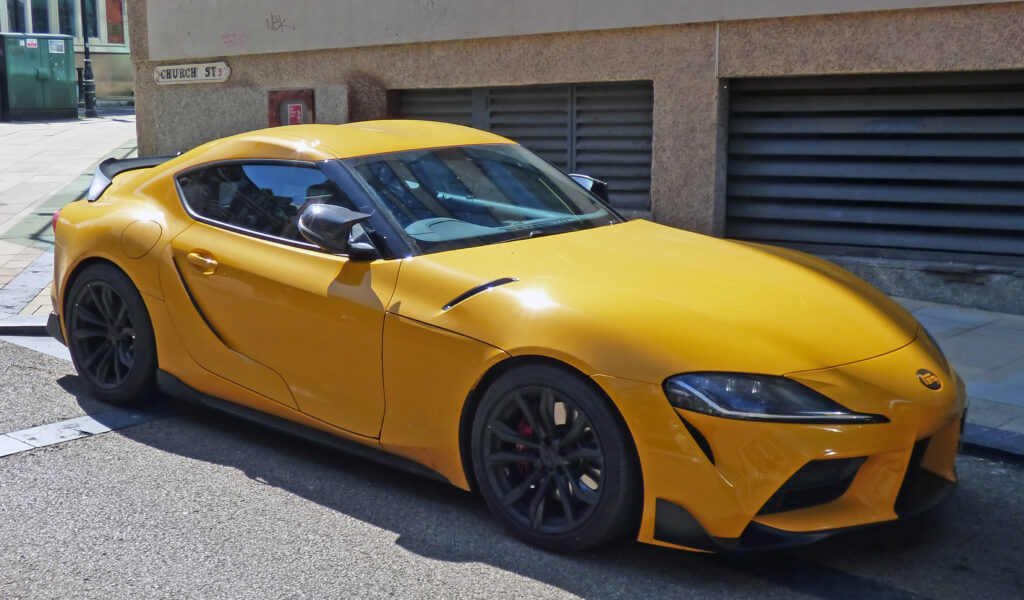
3. **ECU Flash**Unlocking the latent potential within the Mk5 Supra’s stock engine without incurring significant costs on numerous aftermarket parts is a highly appealing proposition for many owners. An ECU flash offers a sophisticated and incredibly effective solution, acting as the digital key to transforming the car’s performance characteristics. This software-based modification allows for precise adjustments to critical engine parameters, yielding impressive gains in horsepower and torque that are otherwise inaccessible.
The VR Tuned ECU Flash Tune comes highly recommended for those seeking to maximize their Supra’s output through intelligent software optimization. This comprehensive tuning solution allows for the Supra’s entire map range to be recalibrated, specifically tailored to deliver impressive numbers whether running on 91 or 93+ octane fuel. It’s a method that delves deep into the engine’s operational blueprint, optimizing every aspect for enhanced performance.
An ECU flash like the one from VR Tuned achieves its results by meticulously increasing boost pressure, fine-tuning fuel delivery, and precisely adjusting ignition timing. Beyond these core parameters, it also modifies torque limiters and other crucial engine management settings, all contributing to a more dynamic and responsive driving experience. The beauty of this particular upgrade lies in its ability to unlock significant hidden horsepower and torque gains, simultaneously enhancing driving characteristics and sharpening throttle response, making the car feel much more alive.
Perhaps one of the most compelling advantages of the VR Tuned ECU flash is its approach to warranty preservation. The design and implementation of this specific ECU flash are carefully considered to help keep your vehicle’s warranty safe, a significant concern for many new car owners. It provides a powerful boost without the typical worries associated with more intrusive hardware modifications, offering a balanced approach to performance enhancement. The real-world results are compelling: stock power rated at 335hp and 369ft/lbs can be elevated to 400hp and 450ft/lbs with the tune. Furthermore, peak gains on a 93 octane stock car can reach 80rwhp at 5500rpm and 70ft/lbs at 4200rpm, while 91 octane still sees substantial improvements of 60rwhp at 5500rpm and 70ft/lbs at 4200rpm.
Car Model Information: 2024 Toyota Supra 3.0 Premium
Name: Toyota Supra
Caption: Toyota GR Supra (J29/DB)
Manufacturer: Toyota
Aka: unbulleted list
Production: unbulleted list
Class: Sports car
BodyStyle: fastback,coupé
Layout: Front-engine, rear-wheel-drive layout
Predecessor: Toyota Celica (A20)
Categories: 1980s cars, 1990s cars, 2000s cars, 2010s cars, 2020s cars
Summary: The Toyota Supra (Japanese: トヨタ・スープラ, Hepburn: Toyota Sūpura) is a sports car and grand tourer manufactured and developed by the Toyota Motor Corporation beginning in 1978. The name “supra” is a definition from the Latin prefix, meaning “above”, “to surpass” or “go beyond”.
The initial four generations of the Supra were produced from 1978 to 2002. The fifth generation has been produced since March 2019 and later went on sale in May 2019. The styling of the original Supra was derived from the Toyota Celica, but it was longer. Starting in mid-1986, the A70 Supra became a separate model from the Celica. In turn, Toyota also stopped using the prefix Celica and named the car Supra. Owing to the similarity and past of the Celica’s name, it is frequently mistaken for the Supra, and vice versa. The first, second and third generations of the Supra were assembled at the Tahara plant in Tahara, Aichi, while the fourth generation was assembled at the Motomachi plant in Toyota City. The 5th generation of the Supra is assembled alongside the G29 BMW Z4 in Graz, Austria by Magna Steyr.
The Supra traces much of its roots back to the 2000GT owing to an inline-6 layout. The first three generations were offered with a direct descendant to the Crown’s and 2000GT’s M engine. Interior aspects were also similar, as was the chassis code “A”. Along with this name, Toyota also included its own logo for the Supra. It was derived from the original Celica logo, being blue instead of orange. This logo was used until January 1986, when the A70 Supra was introduced. The new logo was similar in size, with orange writing on a red background, but without the dragon design. That logo, in turn, was on Supras until 1991 when Toyota switched to its current oval company logo. The dragon logo was a Celica logo regardless of what colour it was. It appeared on the first two generations of the Supra because they were officially Toyota Celicas. The dragon logo was used for the Celica line until it was also discontinued.
In 1998, Toyota ceased sales of the fourth-generation Supra in the United States. Production of the fourth-generation Supra for worldwide markets ended in 2002. In January 2019, the fifth-generation Supra, which was co-developed with the G29 BMW Z4, was introduced.
Get more information about: Toyota Supra
Buying a high-performing used car >>>
Brand: Toyota Model: Supra
Price: $59,995 Mileage: 1,454 mi.
Read more about: 13 Essential Red Flags: Your Step-by-Step Guide to Inspecting a Used Performance Car Like a Pro

4. **Dual Tip Muffler**Beyond raw power and aerodynamic efficiency, the auditory experience of a sports car is a critical component of its allure, and the exhaust system plays a pivotal role in shaping this. Upgrading the muffler is another popular modification for the Mk5 Toyota Supra, offering a direct path to refining the car’s sound profile while often contributing to minor performance improvements through better exhaust flow. It allows owners to personalize their Supra’s voice, giving it a more aggressive or refined tone as desired.
Once again, HKS emerges as a top recommendation in this category, specifically with their HKS Stainless Steel Dual Tip Muffler. Consistent with their brand philosophy, this product is designed as a reliable and environmentally sound performance system, upholding the high standards of engineering and material quality that HKS is known for. It’s an upgrade that promises both aural satisfaction and enhanced aesthetics without compromising on durability or environmental responsibility.
The design philosophy behind this HKS muffler is particularly noteworthy. It was developed through a comprehensive process that actively monitored consumer reaction and input across several key areas: material quality, external appearance, sound quality, and, naturally, performance issues. This iterative approach ensures that the final product is finely tuned to meet the diverse expectations of Supra owners, guaranteeing satisfaction on all fronts and delivering a well-rounded enhancement to the vehicle.
Crafted from SUS304 Stainless Steel for exceptional longevity and corrosion resistance, this dual tip muffler features a visually appealing Titanium Dual Tip with a diameter of 119mm (4.69in). The internal architecture includes an 85mm (3.35in) center pipe diameter and 70mmx2 (2.76in) main pipe diameter, optimized for exhaust gas flow. The sound profile is also significantly enhanced; while the stock noise level is 88db (idle: 58db in sport mode), the HKS muffler produces a more pronounced 90db (idle: 66db in sport mode), offering a throaty and engaging note without being excessively loud. Moreover, like other HKS products, this muffler is designed to be user-friendly and very easy to install, making it an accessible upgrade for many enthusiasts.
The transition from foundational performance to refined aesthetics and ergonomic enhancements is a natural progression for any enthusiast seeking to truly personalize their Toyota Supra Mk5 A90. While the raw power and aerodynamic prowess are captivating, the visual presence and tactile feedback within the cabin are equally vital for a complete and immersive driving experience. This section delves into modifications that elevate the Supra’s curb appeal, interior comfort, and further optimize its exhaust dynamics, ensuring every aspect of the vehicle resonates with its owner’s vision for an even more formidable road weapon.
Car Model Information: 2024 Toyota Supra 3.0 Premium
Name: Toyota Supra
Caption: Toyota GR Supra (J29/DB)
Manufacturer: Toyota
Aka: unbulleted list
Production: unbulleted list
Class: Sports car
BodyStyle: fastback,coupé
Layout: Front-engine, rear-wheel-drive layout
Predecessor: Toyota Celica (A20)
Categories: 1980s cars, 1990s cars, 2000s cars, 2010s cars, 2020s cars
Summary: The Toyota Supra (Japanese: トヨタ・スープラ, Hepburn: Toyota Sūpura) is a sports car and grand tourer manufactured and developed by the Toyota Motor Corporation beginning in 1978. The name “supra” is a definition from the Latin prefix, meaning “above”, “to surpass” or “go beyond”.
The initial four generations of the Supra were produced from 1978 to 2002. The fifth generation has been produced since March 2019 and later went on sale in May 2019. The styling of the original Supra was derived from the Toyota Celica, but it was longer. Starting in mid-1986, the A70 Supra became a separate model from the Celica. In turn, Toyota also stopped using the prefix Celica and named the car Supra. Owing to the similarity and past of the Celica’s name, it is frequently mistaken for the Supra, and vice versa. The first, second and third generations of the Supra were assembled at the Tahara plant in Tahara, Aichi, while the fourth generation was assembled at the Motomachi plant in Toyota City. The 5th generation of the Supra is assembled alongside the G29 BMW Z4 in Graz, Austria by Magna Steyr.
The Supra traces much of its roots back to the 2000GT owing to an inline-6 layout. The first three generations were offered with a direct descendant to the Crown’s and 2000GT’s M engine. Interior aspects were also similar, as was the chassis code “A”. Along with this name, Toyota also included its own logo for the Supra. It was derived from the original Celica logo, being blue instead of orange. This logo was used until January 1986, when the A70 Supra was introduced. The new logo was similar in size, with orange writing on a red background, but without the dragon design. That logo, in turn, was on Supras until 1991 when Toyota switched to its current oval company logo. The dragon logo was a Celica logo regardless of what colour it was. It appeared on the first two generations of the Supra because they were officially Toyota Celicas. The dragon logo was used for the Celica line until it was also discontinued.
In 1998, Toyota ceased sales of the fourth-generation Supra in the United States. Production of the fourth-generation Supra for worldwide markets ended in 2002. In January 2019, the fifth-generation Supra, which was co-developed with the G29 BMW Z4, was introduced.
Get more information about: Toyota Supra
Buying a high-performing used car >>>
Brand: Toyota Model: Supra
Price: $59,995 Mileage: 1,454 mi.
Read more about: Shield Your Ride: Simple, Effective Ways to Banish Rust from Your Truck’s Undercarriage This Winter and Beyond
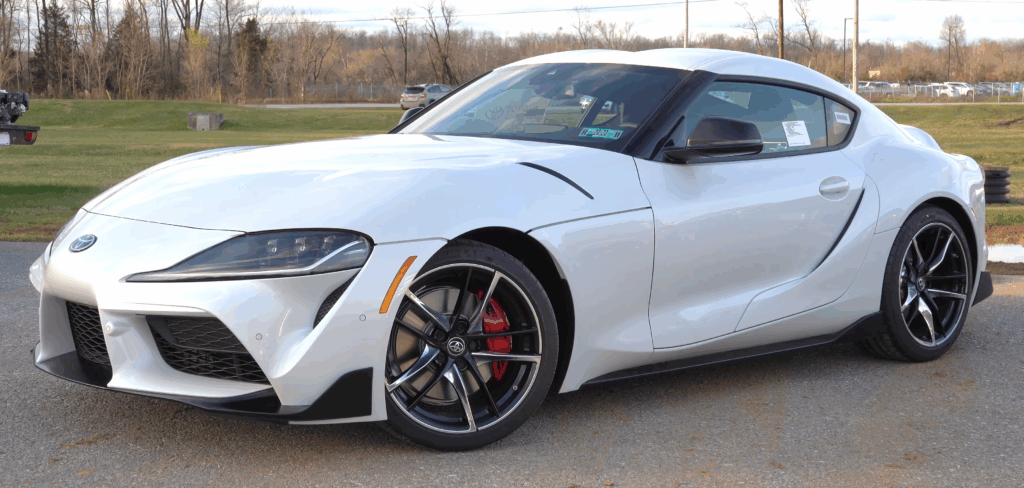
5. **Wheels**There is an undeniable truth in the automotive world: wheels are not just functional components, but powerful statements of style and performance. It is for this very reason that they consistently rank among the premier upgrades for the Toyota Supra Mk5 A90. The right set of aftermarket wheels possesses an extraordinary ability to completely transform the vehicle’s aesthetic, captivating onlookers and turning heads with every rotation, dramatically influencing the car’s overall character.
For those dedicated to achieving a perfect blend of aggressive stance and timeless elegance, the BBS LM wheels present an impeccable choice for the Supra A90. These iconic wheels are celebrated for their exceptional design and are considered a flawless match for the Supra’s athletic body lines. Specifically, configurations such as 20×10 for the front and 20×11 for the rear are lauded for imparting a wonderfully assertive and balanced stance, visually enhancing the car’s planted appearance on the road.
The BBS LM wheels are not just about looks; their construction is equally impressive. Available with a sophisticated Satin Bronze finish, they are meticulously forged, a manufacturing process that precisely optimizes the stiffness-to-weight ratio. This advanced engineering ensures that while the wheels are remarkably strong and light, they also provide the crucial safety and long-term durability that discerning owners expect from a premium brand like BBS. Investing in such wheels means enhancing both the visual appeal and the dynamic integrity of the Supra in one elegant package.
Alternatively, for those with a penchant for a more aggressive, motorsports-inspired aesthetic, the VR Forged D03-R Wheel Package offers a compelling proposition. These wheels are presented in a sleek Matte Black finish, exuding a sense of understated power. As monoblock wheels, they are precision-engineered from a single piece of aluminum, which contributes significantly to their inherent strength and rigidity, qualities highly prized in performance applications and enhancing durability.
The design of the VR Forged D03-R wheels incorporates a distinctive motorsports-inspired ring, a subtle yet impactful detail that reinforces their high-performance pedigree. This design element, combined with their robust construction, ensures that these wheels are incredibly strong and resilient, capable of withstanding the rigors of spirited driving. The D03-R is touted as a perfect match for any “tuner” style vehicle, making it an ideal upgrade for Supra owners who aim for a bolder, more track-focused aesthetic while benefiting from top-tier engineering.
Car Model Information: 2024 Toyota Supra 3.0 Premium
Name: Toyota Supra
Caption: Toyota GR Supra (J29/DB)
Manufacturer: Toyota
Aka: unbulleted list
Production: unbulleted list
Class: Sports car
BodyStyle: fastback,coupé
Layout: Front-engine, rear-wheel-drive layout
Predecessor: Toyota Celica (A20)
Categories: 1980s cars, 1990s cars, 2000s cars, 2010s cars, 2020s cars
Summary: The Toyota Supra (Japanese: トヨタ・スープラ, Hepburn: Toyota Sūpura) is a sports car and grand tourer manufactured and developed by the Toyota Motor Corporation beginning in 1978. The name “supra” is a definition from the Latin prefix, meaning “above”, “to surpass” or “go beyond”.
The initial four generations of the Supra were produced from 1978 to 2002. The fifth generation has been produced since March 2019 and later went on sale in May 2019. The styling of the original Supra was derived from the Toyota Celica, but it was longer. Starting in mid-1986, the A70 Supra became a separate model from the Celica. In turn, Toyota also stopped using the prefix Celica and named the car Supra. Owing to the similarity and past of the Celica’s name, it is frequently mistaken for the Supra, and vice versa. The first, second and third generations of the Supra were assembled at the Tahara plant in Tahara, Aichi, while the fourth generation was assembled at the Motomachi plant in Toyota City. The 5th generation of the Supra is assembled alongside the G29 BMW Z4 in Graz, Austria by Magna Steyr.
The Supra traces much of its roots back to the 2000GT owing to an inline-6 layout. The first three generations were offered with a direct descendant to the Crown’s and 2000GT’s M engine. Interior aspects were also similar, as was the chassis code “A”. Along with this name, Toyota also included its own logo for the Supra. It was derived from the original Celica logo, being blue instead of orange. This logo was used until January 1986, when the A70 Supra was introduced. The new logo was similar in size, with orange writing on a red background, but without the dragon design. That logo, in turn, was on Supras until 1991 when Toyota switched to its current oval company logo. The dragon logo was a Celica logo regardless of what colour it was. It appeared on the first two generations of the Supra because they were officially Toyota Celicas. The dragon logo was used for the Celica line until it was also discontinued.
In 1998, Toyota ceased sales of the fourth-generation Supra in the United States. Production of the fourth-generation Supra for worldwide markets ended in 2002. In January 2019, the fifth-generation Supra, which was co-developed with the G29 BMW Z4, was introduced.
Get more information about: Toyota Supra
Buying a high-performing used car >>>
Brand: Toyota Model: Supra
Price: $59,995 Mileage: 1,454 mi.
Read more about: Your Ultimate Guide to Savvy Negotiations: Simple Strategies for Securing the Best Price on a Rare Classic Car
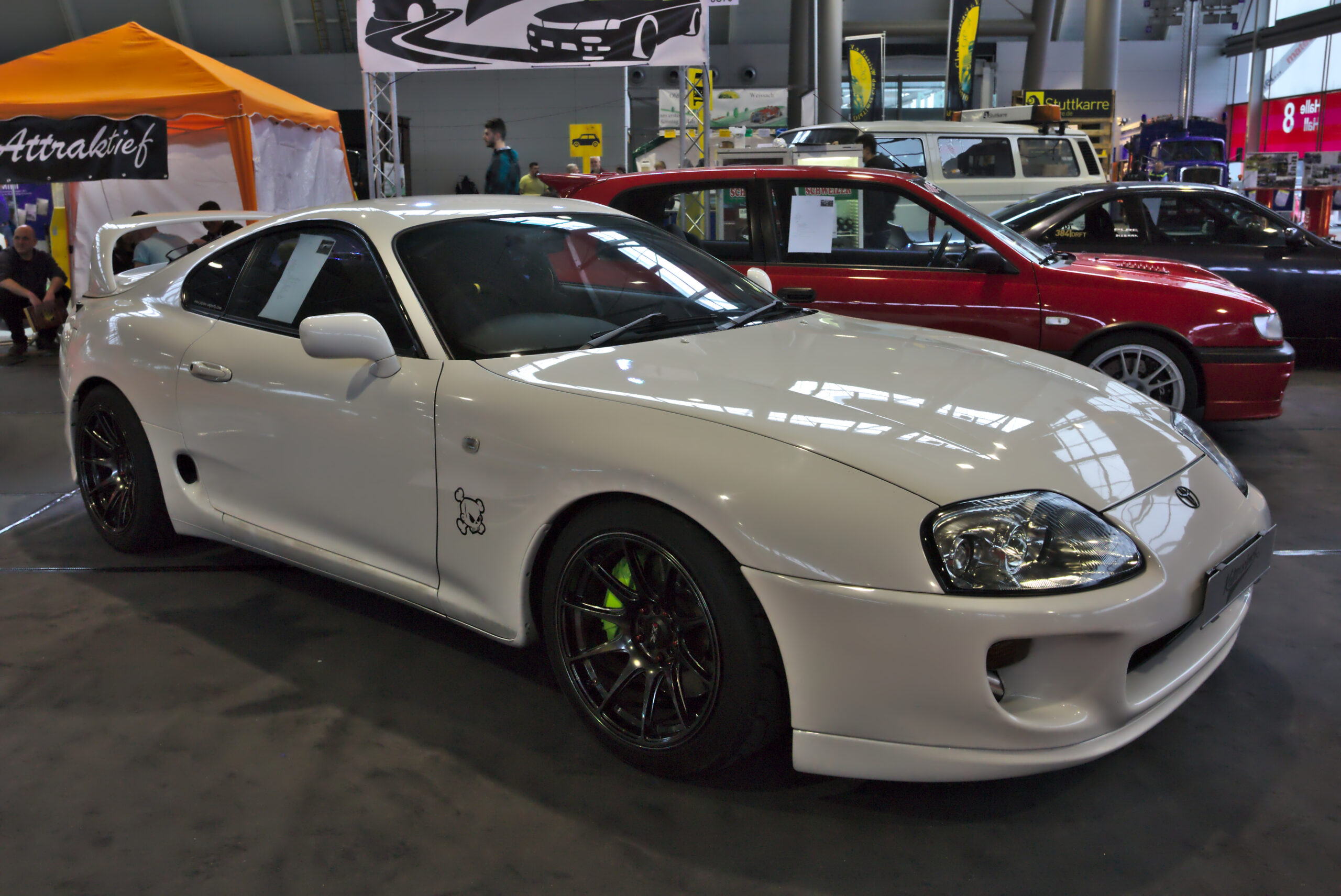
6. **Steering Wheel**While much attention is often directed towards external modifications and powertrain enhancements, the interior of a vehicle serves as the direct interface between driver and machine. A steering wheel upgrade, often overlooked, holds immense potential to fundamentally change the tactile experience and luxurious feel of the Toyota Supra Mk5 A90’s cabin. It is a modification that profoundly impacts proper ergonomics, offering a level of comfort and driver connection that the standard OEM steering wheel simply cannot rival.
Among the top recommendations are the steering wheel upgrades manufactured by Vivid Racing, designed with a keen focus on enhancing the driver’s engagement. These upgrades notably feature beefier hand grips precisely positioned at the 9 and 3 o’clock positions. This thoughtful ergonomic design is not merely for aesthetics; it provides a significantly more substantial and secure grip, promoting proper driving posture and improving control, especially during dynamic maneuvers where precise input is critical.
The beauty of these steering wheel upgrades lies in their extensive configurability, allowing owners to tailor the wheel to their exact preferences and interior scheme. A vast array of options is available, including a choice of a colored 12 o’clock ring, which can serve as a visual cue for wheel orientation, along with matching stitching that adds a touch of bespoke craftsmanship. Furthermore, owners can select from a variety of premium materials such as supple leather, high-tech carbon fiber, perforated leather for enhanced grip and breathability, or luxurious Alcantara, each offering a distinct feel and visual appeal.
A significant advantage of opting for Vivid Racing’s steering wheel upgrade is its smart design philosophy: these wheels are crafted using a factory steering wheel core. This ingenious approach means that owners can seamlessly retain their original buttons and existing trim, ensuring full functionality and integration with the vehicle’s electronic systems. Crucially, the original airbag can also be reused, maintaining the vital safety features of the Supra. This is not a simple slip-on cover; it is presented as a better-engineered steering wheel, offering a complete and integrated enhancement without compromise.
To further illustrate the level of detail available, a specific configuration highlights the possibilities: a 12 O’Clock Stripe and stitching meticulously rendered in a vibrant tri-color Toyota red, orange, and yellow combination, paying homage to performance heritage. This is complemented by Black Alcantara hand grips, providing a luxurious and grippy surface, and a glossy black carbon fiber center trim for a sophisticated, sporty touch. Additionally, some configurations can even include a Shift Light, providing a clear visual cue for optimal gear changes, further enhancing the driving experience with a nod to racing functionality.
Car Model Information: 2023 Dodge Charger GT
Categories: All articles containing circular references, All articles lacking reliable references, All articles to be expanded, All articles with dead external links, All articles with unsourced statements
Summary: This is a list of lap times achieved by various vehicles on the Nürburgring (Nordschleife). The list itself is broken down into categories.
Get more information about: List of Nürburgring Nordschleife lap times
Buying a high-performing used car >>>
Brand: Toyota Model: Supra Mk5 A90
Price: $26,690 Mileage: 19,257 mi.
Read more about: Shield Your Ride: Simple, Effective Ways to Banish Rust from Your Truck’s Undercarriage This Winter and Beyond

7. **Aero & Body Kit**The inherent beauty of the Toyota Supra Mk5 A90 is widely acknowledged, yet for many enthusiasts, there’s always room for personalization and further aesthetic refinement. Aftermarket aero and body kits offer an exciting avenue to achieve this, allowing owners to enhance the Supra’s already stunning lines while often contributing to improved aerodynamic performance. The key lies in selecting parts that harmoniously complement the original design, elevating its visual appeal without detracting from its iconic silhouette.
Among the favored choices for aesthetic enhancement is the kit from AimGain. Originating from Japan, this aero set is meticulously crafted from Fiber Reinforced Plastics (FRP), a material known for its lightweight properties and durability, making it an excellent choice for automotive body components. This particular kit is highly regarded not only for its striking visual impact but also for its capacity to improve the Supra’s aerodynamics, a dual benefit that appeals to both performance-oriented and style-conscious owners.
The AimGain aero kit offers a modular approach to customization, with various parts available allowing owners to tailor the extent of their modification based on their preferences and budget. Individual components that can be chosen include a Front Spoiler, which enhances the car’s aggressive stance and manages airflow over the front end; Sideskirts, which streamline the vehicle’s profile; a Rear Side Skirt, complementing the rear aesthetics; a Rear Diffuser, crucial for optimizing airflow under the car and increasing downforce; and a Roof Spoiler, adding a subtle yet sporty touch to the car’s upper profile. The availability of these distinct parts means that pricing varies, offering flexibility to enthusiasts.
For those seeking an even more dramatic transformation and an unmistakable presence on the road, the widebody kit by Pandem, specifically the Pandem Rocket Bunny Full Wide Body Aero Kit, stands as an exceptional choice. This kit is celebrated for its incredible style and aggressive, race-inspired aesthetics that truly set a Supra apart from the crowd. What truly distinguishes this design is the careful attention paid to ensure it doesn’t overpower or “ruin” the key features of the original car’s design, instead working with them to create a cohesive and amplified visual statement.
The Pandem Rocket Bunny kit goes beyond mere embellishment; it fundamentally enhances the look of the already-stunning A90 Supra, pushing its visual boundaries and definitely exceeding standard expectations. Choosing this design is a definitive declaration for any owner who wishes to stand out, transforming their Supra into a show-stopping vehicle with an aggressive, wide-stance aesthetic that demands attention and reflects a deep commitment to high-impact styling and a unique identity.
Car Model Information: 2024 Toyota Supra 3.0 Premium
Name: Toyota Supra
Caption: Toyota GR Supra (J29/DB)
Manufacturer: Toyota
Aka: unbulleted list
Production: unbulleted list
Class: Sports car
BodyStyle: fastback,coupé
Layout: Front-engine, rear-wheel-drive layout
Predecessor: Toyota Celica (A20)
Categories: 1980s cars, 1990s cars, 2000s cars, 2010s cars, 2020s cars
Summary: The Toyota Supra (Japanese: トヨタ・スープラ, Hepburn: Toyota Sūpura) is a sports car and grand tourer manufactured and developed by the Toyota Motor Corporation beginning in 1978. The name “supra” is a definition from the Latin prefix, meaning “above”, “to surpass” or “go beyond”.
The initial four generations of the Supra were produced from 1978 to 2002. The fifth generation has been produced since March 2019 and later went on sale in May 2019. The styling of the original Supra was derived from the Toyota Celica, but it was longer. Starting in mid-1986, the A70 Supra became a separate model from the Celica. In turn, Toyota also stopped using the prefix Celica and named the car Supra. Owing to the similarity and past of the Celica’s name, it is frequently mistaken for the Supra, and vice versa. The first, second and third generations of the Supra were assembled at the Tahara plant in Tahara, Aichi, while the fourth generation was assembled at the Motomachi plant in Toyota City. The 5th generation of the Supra is assembled alongside the G29 BMW Z4 in Graz, Austria by Magna Steyr.
The Supra traces much of its roots back to the 2000GT owing to an inline-6 layout. The first three generations were offered with a direct descendant to the Crown’s and 2000GT’s M engine. Interior aspects were also similar, as was the chassis code “A”. Along with this name, Toyota also included its own logo for the Supra. It was derived from the original Celica logo, being blue instead of orange. This logo was used until January 1986, when the A70 Supra was introduced. The new logo was similar in size, with orange writing on a red background, but without the dragon design. That logo, in turn, was on Supras until 1991 when Toyota switched to its current oval company logo. The dragon logo was a Celica logo regardless of what colour it was. It appeared on the first two generations of the Supra because they were officially Toyota Celicas. The dragon logo was used for the Celica line until it was also discontinued.
In 1998, Toyota ceased sales of the fourth-generation Supra in the United States. Production of the fourth-generation Supra for worldwide markets ended in 2002. In January 2019, the fifth-generation Supra, which was co-developed with the G29 BMW Z4, was introduced.
Get more information about: Toyota Supra
Buying a high-performing used car >>>
Brand: Toyota Model: Supra
Price: $59,995 Mileage: 1,454 mi.
Read more about: The Blink and You Missed It: 10 Iconic Pop-Up Headlights That Vanished From Car Design
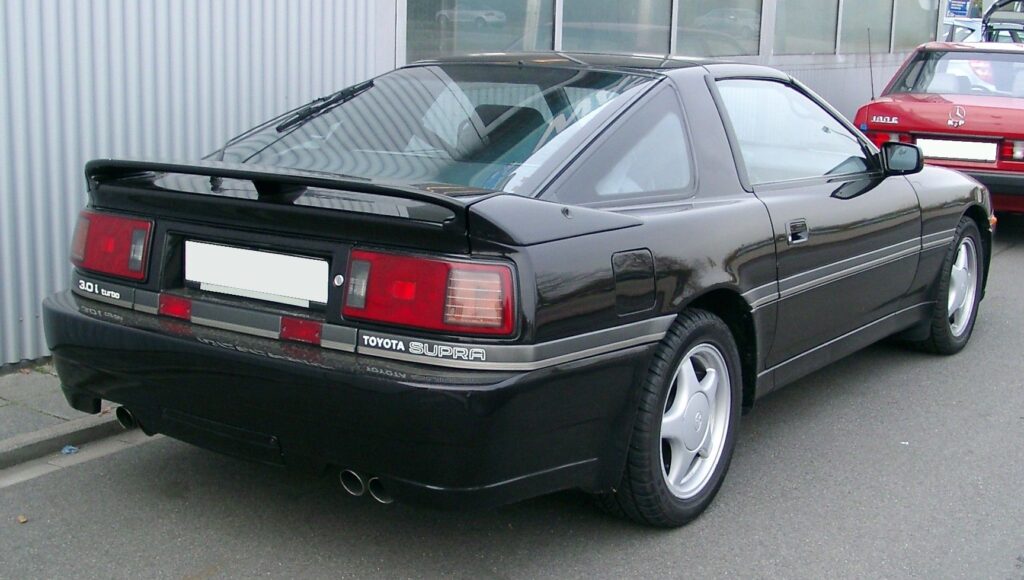
8. **Race Downpipe**Finally, completing our exploration of impactful modifications for the Toyota Supra Mk5 A90, we arrive at an upgrade that significantly enhances both performance and sound: the race downpipe. This critical component plays a pivotal role in optimizing exhaust gas flow directly from the turbocharger, unlocking greater power potential and refining the auditory experience of the vehicle. Often considered a gateway modification, it maximizes engine efficiency and adds aural aggression.
Among the leading options in this category is the AMS Performance MKV Toyota Supra Stainless Steel Race Downpipe. This meticulously engineered component features a 4.5” full mandrel-bent design, ensuring exceptional flow characteristics by maintaining a consistent diameter throughout its length. The high-quality construction and precise bending are crucial for minimizing turbulence and maximizing the efficiency with which exhaust gases exit the turbo, directly contributing to superior engine performance and delivering immediate benefits like earlier power and significantly improved turbo spool-up.
The long, gradual transitions designed into the mandrel-bent pipe are key to these gains, allowing exhaust gases to maintain optimal velocity without encountering a buildup of detrimental back pressure. This downpipe from AMS stands out for its superior performance and enhanced durability, unlike some alternatives prone to cracking. Its design ensures significantly lower back pressure, translating into more power by allowing exhaust gas to flow more easily across the turbine wheel, enabling the turbocharger to operate more efficiently and build boost with less effort.
Furthermore, beyond its performance advantages, the AMS downpipe also delivers a distinct and throaty exhaust note, particularly under wide-open throttle, adding a visceral layer to the driving experience. Technically, it is CAD-engineered for maximum exhaust flow alongside unrivaled fit and finish. It features a robust 304 stainless steel 4.5″ design that thoughtfully reduces to a 3.5″ flex section, a configuration that cleverly maximizes both volume and flow without compromising integrity.
The design also includes a turbine flange that offers a remarkably smooth transition from the turbine outlet, further aiding in efficient gas evacuation. With a 3.15″ (80mm) outlet, this downpipe is highly versatile, allowing owners the flexibility to run either the stock cat-back system or various aftermarket cat-back setups. Installation is simplified as it’s a complete bolt-on solution, requiring no cutting and securing directly to the factory location, with O2 sensors accommodated in their OEM spots. The comprehensive kit includes the fully stainless steel downpipe and an adjustable mounting bracket, providing everything needed for a straightforward and impactful upgrade.
**Unlocking the Full Potential of the Mk5 Supra**
Car Model Information: 2024 Toyota Supra 3.0 Premium
Name: Toyota Supra
Caption: Toyota GR Supra (J29/DB)
Manufacturer: Toyota
Aka: unbulleted list
Production: unbulleted list
Class: Sports car
BodyStyle: fastback,coupé
Layout: Front-engine, rear-wheel-drive layout
Predecessor: Toyota Celica (A20)
Categories: 1980s cars, 1990s cars, 2000s cars, 2010s cars, 2020s cars
Summary: The Toyota Supra (Japanese: トヨタ・スープラ, Hepburn: Toyota Sūpura) is a sports car and grand tourer manufactured and developed by the Toyota Motor Corporation beginning in 1978. The name “supra” is a definition from the Latin prefix, meaning “above”, “to surpass” or “go beyond”.
The initial four generations of the Supra were produced from 1978 to 2002. The fifth generation has been produced since March 2019 and later went on sale in May 2019. The styling of the original Supra was derived from the Toyota Celica, but it was longer. Starting in mid-1986, the A70 Supra became a separate model from the Celica. In turn, Toyota also stopped using the prefix Celica and named the car Supra. Owing to the similarity and past of the Celica’s name, it is frequently mistaken for the Supra, and vice versa. The first, second and third generations of the Supra were assembled at the Tahara plant in Tahara, Aichi, while the fourth generation was assembled at the Motomachi plant in Toyota City. The 5th generation of the Supra is assembled alongside the G29 BMW Z4 in Graz, Austria by Magna Steyr.
The Supra traces much of its roots back to the 2000GT owing to an inline-6 layout. The first three generations were offered with a direct descendant to the Crown’s and 2000GT’s M engine. Interior aspects were also similar, as was the chassis code “A”. Along with this name, Toyota also included its own logo for the Supra. It was derived from the original Celica logo, being blue instead of orange. This logo was used until January 1986, when the A70 Supra was introduced. The new logo was similar in size, with orange writing on a red background, but without the dragon design. That logo, in turn, was on Supras until 1991 when Toyota switched to its current oval company logo. The dragon logo was a Celica logo regardless of what colour it was. It appeared on the first two generations of the Supra because they were officially Toyota Celicas. The dragon logo was used for the Celica line until it was also discontinued.
In 1998, Toyota ceased sales of the fourth-generation Supra in the United States. Production of the fourth-generation Supra for worldwide markets ended in 2002. In January 2019, the fifth-generation Supra, which was co-developed with the G29 BMW Z4, was introduced.
Get more information about: Toyota Supra
Buying a high-performing used car >>>
Brand: Toyota Model: Supra
Price: $59,995 Mileage: 1,454 mi.
Read more about: Beyond the Boomer Icons: Why Millennials Are Steering Clear of These Classic Cars and Reshaping the Collector Market
Whether you’re aiming for daily drivability, track-day dominance, or show-stopping style, these upgrades offer proven ways to elevate your Mk5 Supra’s performance and personality. From powertrain enhancements to aero kits and interior touches, each mod serves a purpose, and when combined, they unlock a driving experience that goes far beyond stock. As the A90 Supra platform continues to evolve, the aftermarket support only grows stronger. That means more choices, more capability, and more opportunities to make your Supra truly your own.



